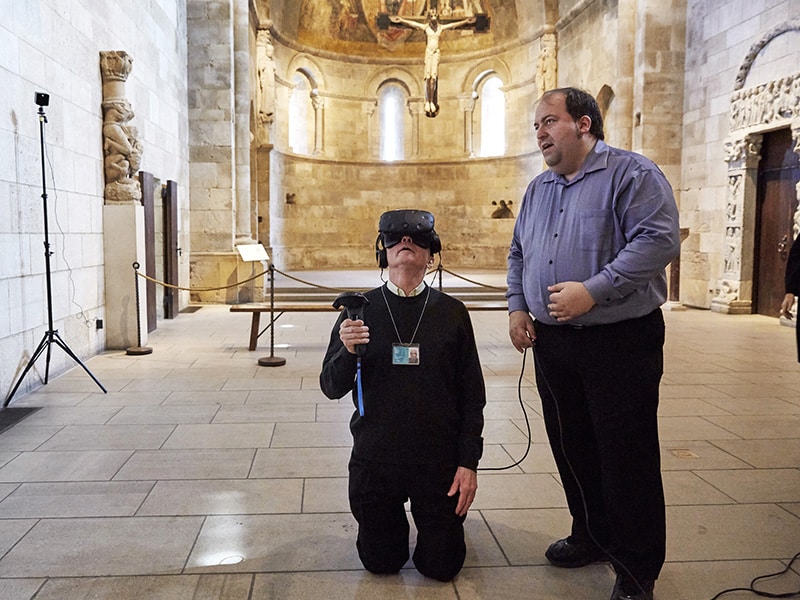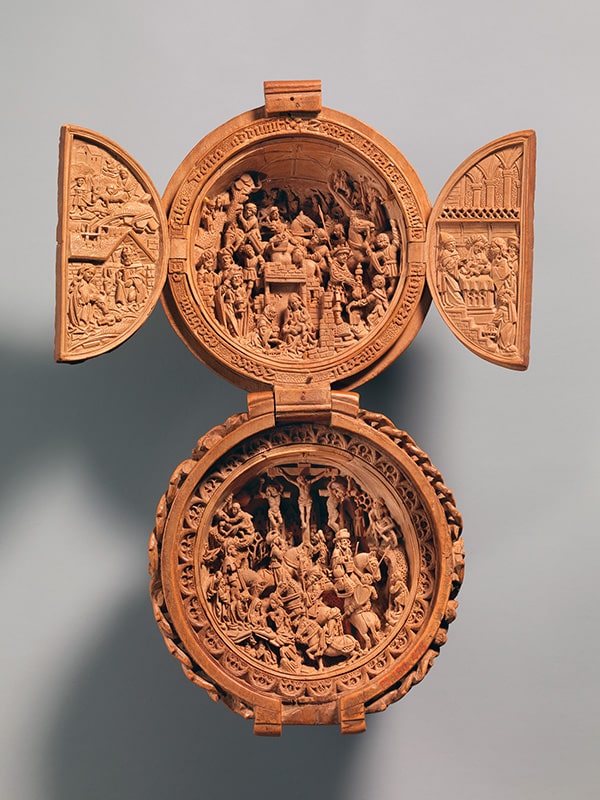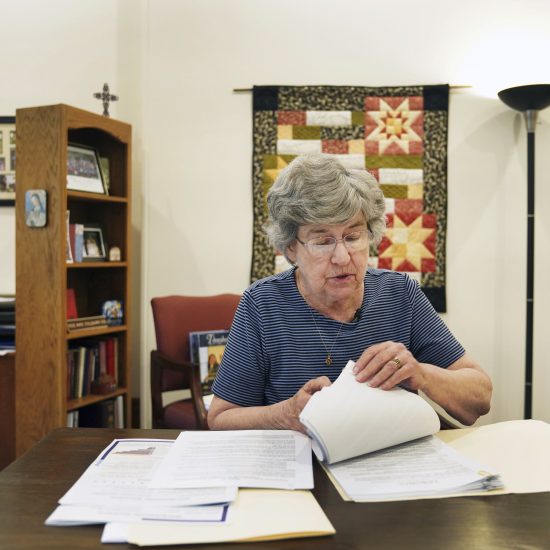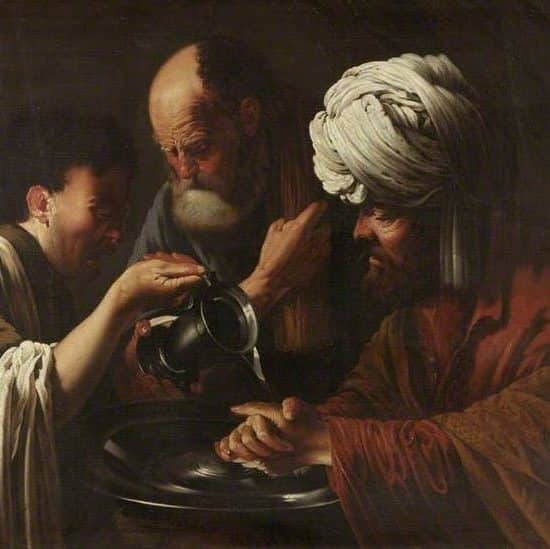NEW YORK (RNS) It’s an artistic rendering of the Last Judgment, with all the trimmings.
At the top of one of the hardwood sculptures currently on view at The Met Cloisters in Manhattan stands Jesus, flanked by saints and angels, two of whom are blowing the final trumpets. Beneath them, carved in deep relief, are souls in purgatory, prodded by demons, moaning as their fate is decided. At the sculpture’s base is the gaping maw of hell consuming someone.
 The Rev. Xavier Seubert, left, of the Friary of St. Francis of Assisi in Manhattan explores the interior of an intricately carved prayer bead using a VR headset, guided by Joseph Ellsworth of the Canadian Film Center, on April 3, 2017. The exhibit “Small Wonders: The VR Experience” at The Met Cloisters Museum in New York City is an immersive experience that takes museum patrons inside a miniature, wooden prayer bead using micro-CT imaging technology and a VR headset. RNS photo by Steve RemichEven if this were a normal-size work of art, the detailed, perfectly balanced presentation of its 50-plus figures would be remarkable.
The Rev. Xavier Seubert, left, of the Friary of St. Francis of Assisi in Manhattan explores the interior of an intricately carved prayer bead using a VR headset, guided by Joseph Ellsworth of the Canadian Film Center, on April 3, 2017. The exhibit “Small Wonders: The VR Experience” at The Met Cloisters Museum in New York City is an immersive experience that takes museum patrons inside a miniature, wooden prayer bead using micro-CT imaging technology and a VR headset. RNS photo by Steve RemichEven if this were a normal-size work of art, the detailed, perfectly balanced presentation of its 50-plus figures would be remarkable.
But it’s all carved inside a 2-inch-high sphere.
This is a story about a mysterious artist, his glorious art, a failed royal marriage and virtual-reality goggles. And, oh yes, faith preserved 500 years in a wooden ball the size of a peach.
Rosary beads with a secret
The stars of “Small Wonders: Gothic Boxwood Miniatures” are 40 of those balls. Their putative function was as the final prayer beads in large rosaries; but in fact they were much more.
 Netherlandish Prayer Bead with the Adoration of the Magi and the Crucifixion, early 16th century, boxwood. Photo courtesy of The Metropolitan Museum of Art, New YorkEach opens on diminutive hinges to reveal fantastically meticulous scenes of subjects such as Jesus, the Virgin Mary, the saints and Bible stories. The beads, carved from the fine-grained wood of a small evergreen called the boxwood, have a near-magical depth.
Netherlandish Prayer Bead with the Adoration of the Magi and the Crucifixion, early 16th century, boxwood. Photo courtesy of The Metropolitan Museum of Art, New YorkEach opens on diminutive hinges to reveal fantastically meticulous scenes of subjects such as Jesus, the Virgin Mary, the saints and Bible stories. The beads, carved from the fine-grained wood of a small evergreen called the boxwood, have a near-magical depth.
“It seems as though you almost tumble into them,” said Barbara Drake Boehm, senior curator at The Cloisters. “They’re these hidden worlds — the grown-up evolution of the sugar Easter eggs with the peephole and the tiny rabbits and chicks inside.”
The show is something of a celebration: After years of frustration, scholars can finally explain how the beads’ anonymous creator achieved some of the effects that make them one of history’s great combinations of piety, ingenuity and outrageous luxury.
The carvings, which date to the years 1500 to 1530, mimic huge altarpieces being produced at the time in the southern Netherlands — but on a Lilliputian scale and with a virtuoso’s restless touch. (For instance: Out of the 130 beads that have survived to the present, 30 portray Jesus carrying his cross — but no two are exactly alike.)
The beads were once the ultimate luxury item: a bit like a gold-plated Lamborghini, but to take you to heaven rather than the latest hot club. Their most famous, over-the-top example is all 10 beads of a short rosary that was a wedding gift to Henry VIII and Catherine of Aragon in 1509.
But the beads’ eventual 21st-century distribution in small collections across Europe and North America made comparative study difficult, and no one could figure out how they were made. Too small to snake an endoscopic camera into, they also foiled standard X-rays, which came out oddly blotchy.
They remained well-known in their respective locales.
Never before seen
Then, in 2014, modern technology caught up with medieval sleight of hand. Employing a micro-CT scan more commonly used by the military, curators from the Art Gallery of Ontario noninvasively captured up to 3,000 digital “slices” of each bead’s interior.
Some clarity resulted. Instead of one or even two overlapping layers of shallowly carved wood, the beads contained up to five, stacked like flats in a stage set, which explained why simple X-rays failed. Despite these wafers’ impossible thinness, many were carved in three-quarter-inch relief, and even in the round.
The fact that viewers could not see the back, and sometimes even their front, didn’t trouble their maker: A tiny, fully realized portrait of Henry and Catherine sitting in a gallery was invisible to the actual king and queen, or anyone else. Some of the pieces slotted into thin grooves; others were attached with pins the size of a sesame seed.
This was enough information to support the current show. But questions remained. Ontario Gallery curator Alexandra Suda recalls one expert sputtering that since scholars think 16th-century optics only allowed for 5x magnification, “history as written does not allow for these things to be made.”
“I told her, ‘I think we have to consider that the history isn’t exactly accurate,’” Suda said. “These objects are disruptors.”
The identity of the master of the beads is also still up for grabs.
An inscription on one reads, “Adam Theodoric made me,” but the curators agree that Theodoric could have been a patron rather than the artist.
Pete Dandridge, the show’s New York conservator, feels certain that “they were all made in one generation. One artist. One human being.” Some of his colleagues prefer the idea of a workshop employing artisans of varying skill.
The most important question, though, may be whether the beads still have the power to inspire faith today. Or, for that matter, did they move the 16th-century royalty and plutocrats who snapped them up? Henry appears to have returned his when he pulled England out of Roman Catholicism, partly to end his marriage to Catherine. Not long after, his Church of England banned rosaries altogether.
The virtual-reality experience
An answer to the current-day faith question was evident on a recent spring morning. Every few weeks (the next dates are May 12-14) the museum enhances the miniatures exhibit by offering a 3-D virtual-reality tour of one of the beads, scaled so the figures are life-size. The Rev. Xavier Seubert, an art historian, theologian and superior (or “guardian”) of the New York City Franciscan friary, brought along several fellow Franciscans.
One by one they donned goggles and found themselves strolling through a Last Judgment bead, among its Jesus, angels, demons and the newly resurrected dead clambering from their graves.
Having walked right up to the figure of Jesus, Brother Ramon Razon said: “That will stick. It’ll be one of my visualizations of God.”
“This was a wonderful experience,” said Seubert. But he preferred the boxwood beads tiny, the way the 16th-century genius carved them.
“In the immensity of the universe,” he said, “we’re like that — we’re a speck of dust. That the immensity of God’s love could love something as small as ourselves … ” Seubert quoted a letter about another instance of big things made small by his order’s founder, who practiced a mystical poverty that was very un-Henry-the-VIII:
“O wonderful loftiness and stupendous dignity!
O sublime humility, O humble sublimity!
The Lord of the universe, God and the Son of God,
so humbles Himself that for our salvation
He hides himself under an
ordinary piece of bread!”
(David Van Biema is a New York-based correspondent)


